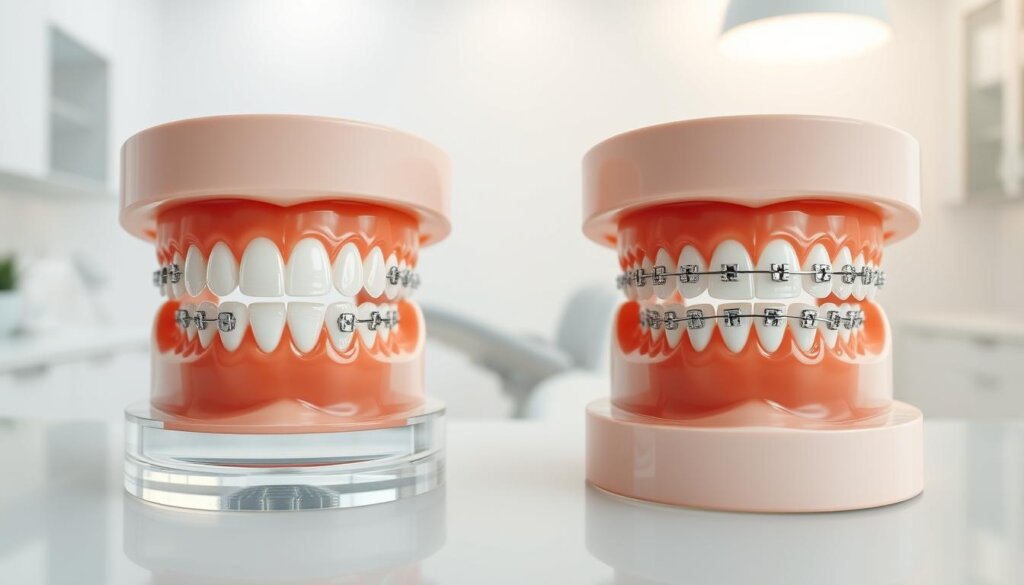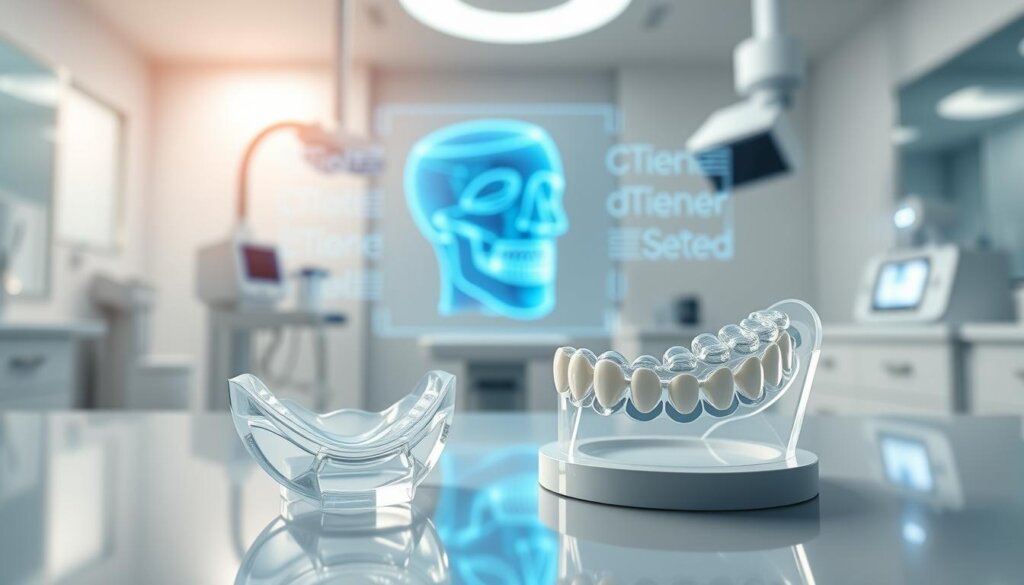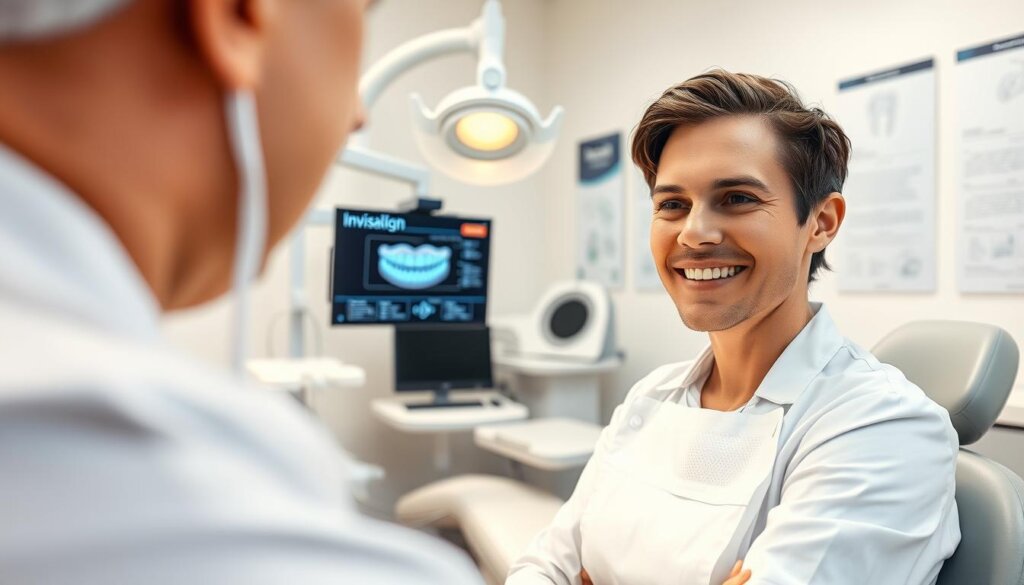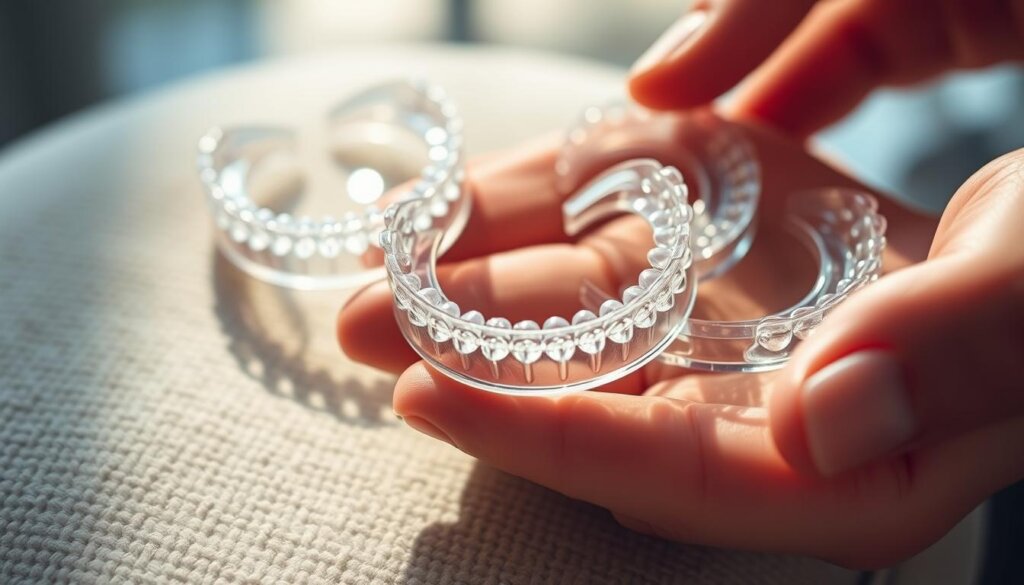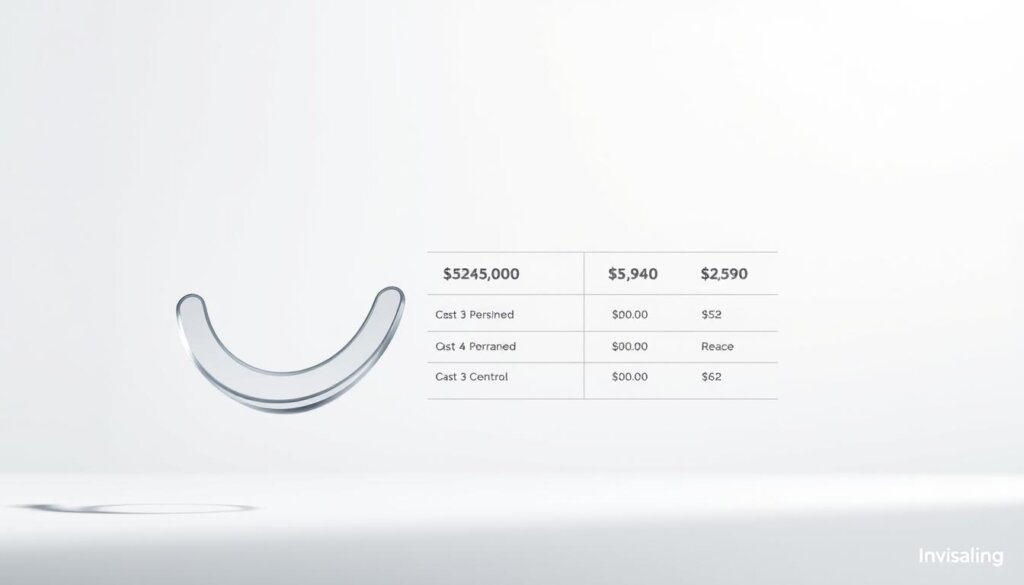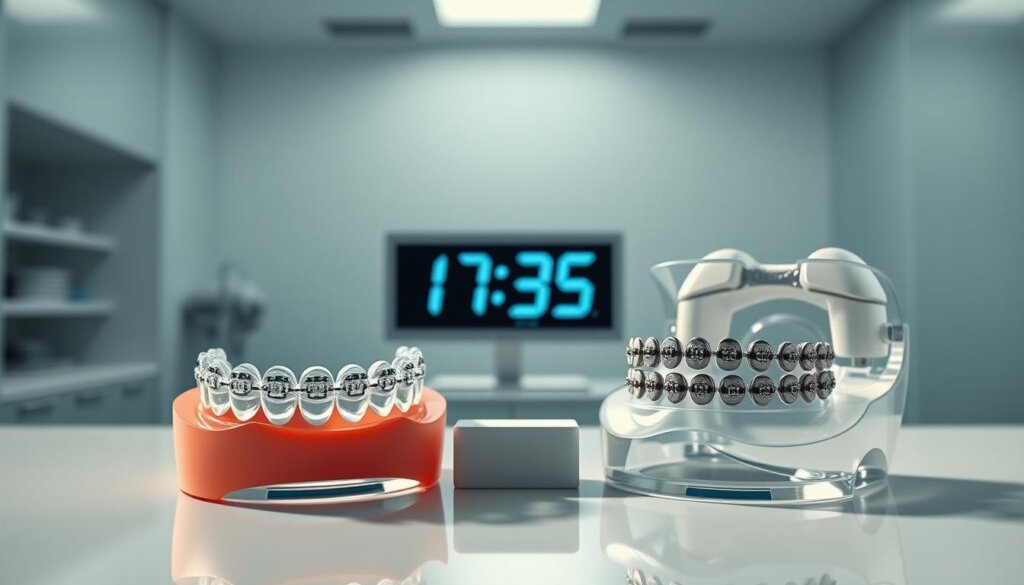Is Invisalign Effective for Adults and Teens Alike?
Today, 25% of people getting orthodontic treatments are adults, showing that people of all ages want a better smile. Invisalign has become a popular choice for those looking to straighten their teeth. People often wonder if Invisalign works well for both adults and teenagers. With its clear, removable aligners, Invisalign offers a barely noticeable solution designed for any age.
Invisalign is loved not only for how it looks but also for solving many dental problems. It’s made just for you, providing a comfier and easier option than old-school braces. It helps with issues like crowded teeth, gaps, and bites, no matter how old you are. But, wearing your aligners a lot is key to getting great results.
Invisalign treats adults and teens equally well, with benefits for both. The aligners are made of smooth plastic for comfort and can be taken out easily. This means you can live your life normally while getting treatment. Usually, Invisalign works faster than traditional braces, allowing for quicker celebrations of new smiles.
Key Takeaways
- Invisalign’s efficacy spans across both adults and teens, offering orthodontic correction with an almost invisible presence.
- Addressing common dental issues, Invisalign aligners present a comfortable and aesthetic solution compared to traditional braces.
- Treatment success is highly dependent on the patient’s commitment to consistent and proper usage of the aligners.
- While Invisalign provides numerous advantages, it upholds the importance of an individual assessment to ascertain its suitability for each case.
- Potential reductions in treatment duration constitute one of Invisalign’s attractive features, setting it apart from traditional orthodontic methods.
Understanding Invisalign: Overview of the Treatment
Invisalign is a modern fix for teeth straightening, offering a way to fix teeth without showing. This part talks about how Invisalign works, moving from the beginning idea to becoming a top choice for adults and teens.
What is Invisalign?
Invisalign aligners are clear and made just for you, gently moving your teeth. They fit into your life without the trouble of regular braces. This makes getting a great smile easier for adults and teens.
How Does Invisalign Work?
The process starts with 3D images of your mouth to plan your treatment. You wear each pair of aligners for about two weeks, slowly straightening your teeth. Invisalign is liked because it’s easy and doesn’t get in the way of daily life.
History of Invisalign Treatment
Invisalign began in the late 1990s, offering an unseen way to straighten teeth. It changed orthodontics by removing the need for metal braces. Now, as a top name in clear aligners, Invisalign keeps improving the way we straighten teeth.
The Benefits of Choosing Invisalign
Nowadays, for the perfect smile, adults and teens prefer options that don’t sacrifice looks or comfort. Invisalign uses top technology and design focused on the patient. It brings unique benefits that match what users want.
Discreet Appearance
The Invisalign benefits for adults and teens include its almost invisible aligners. Unlike traditional braces with metal brackets and wires, Invisalign doesn’t draw attention. This discreet Invisalign system moves teeth well but stays hidden. It helps people feel more confident at work and with friends.
Comfort Compared to Traditional Braces
Invisalign comfort is key over braces. Each piece is made to fit perfectly, using smooth, safe plastic. This avoids the cuts or scrapes metal braces can cause. Plus, you can take Invisalign out to clean your teeth or eat whatever you like.
Reduced Treatment Time
Getting straight teeth fast is important. Invisalign treatment time usually takes 12 to 18 months, sometimes less. This is thanks to the iTero Element scanner, which accurately maps teeth for a custom-fit.
| Feature | Invisalign | Traditional Braces |
|---|---|---|
| Visibility | Nearly Invisible | Noticeable |
| Comfort Level | High (custom-fit aligners) | Low (metal brackets) |
| Average Treatment Duration | 12-18 months | 18-24 months |
Invisalign offers beauty, comfort, and speed in orthodontic treatment. For many, it’s the way to get a confident smile and live their best life.
Invisalign for Adults: Effectiveness Evaluated
Adults looking for orthodontic treatments want something effective that won’t disrupt their daily life. Invisalign is a perfect choice for them. It fits well into adult life without hurting their professional image or comfort. This has made Invisalign increasingly popular among adults.
Invisalign effectiveness for adults is really high, as shown by many studies. It works well for various dental problems. Whether it’s simple straightening or fixing complex bite issues, Invisalign is a good choice for adults. Let’s look into how well Invisalign aligners work, including their clinical success rates and how they blend into adult life.
Case Studies and Success Rates
Studies show that Invisalign has high success rates for adults. Case studies show great improvement in dental alignment and patient happiness. Adults who had braces before say that Invisalign worked better and faster for them than their original treatments.
Specific Dental Issues Addressed
Invisalign aligners can fix many common dental problems in adults. They offer personalized plans for fixing overbites, underbites, crossbites, or just making smiles straighter. These clear aligners work well without the downsides of traditional metal braces.
Lifestyle Compatibility
Invisalign aligners are a great fit for adults. They are clear and can be removed, so adults don’t have to change their lifestyle. They are especially good for professionals. They allow adults to fix their teeth without anyone noticing, so their social and work life isn’t affected.
| Dental Issue | Treatment Duration (Months) | Success Rate (%) |
|---|---|---|
| Overbite Correction | 12-18 | 95 |
| Gap Closure | 6-12 | 90 |
| Straightening Crooked Teeth | 12-24 | 98 |
Invisalign for Teens: A Comprehensive Look
Invisalign for teens is designed for younger people’s unique dental needs. It fits perfectly into their busy lives and makes orthodontic adjustments easy. This part talks about how well Invisalign works for teens, why parents need to be involved, and how friends feel about these treatments.
Effectiveness in Growing Teeth
The changing oral health of teens is a big challenge. Invisalign for adolescents meets this challenge with its advanced technology. These aligners work well for growing teeth, adapt to changing needs, and keep teeth moving correctly. And, they do this all without the noticeable look of traditional braces.
Involving Parents in the Process
For Invisalign to work best for teens, parents must play a big role. Their support helps make sure that teens wear their aligners as they should. Working together makes the treatment work better and teaches teens to take care of their teeth.
Peer Influence and Acceptance
Invisalign is popular among teens because it’s hard to see. Peer acceptance of Invisalign is high because it doesn’t change how teens look. This matters a lot since teens worry about bullying or feeling left out if they wear braces.
Teens like Invisalign because it doesn’t make them feel different at school. Friends’ opinions matter a lot at this age. The invisible design of Invisalign helps teens fit in while getting a better smile.
In summary, Invisalign is a total package for teen dental growth. It gets parents involved and makes sure friends are okay with it. It meets both the look and medical needs of teens.
Comparing Invisalign to Traditional Braces
Choosing between Invisalign and traditional braces needs careful thought. Both have their own benefits and downsides that matter. This makes it important to compare them closely before deciding.
There are good and bad points to each choice. Invisalign is less noticeable because of its clear aligners, unlike the visible metal brackets of braces. Braces are often better for fixing complex dental problems, where Invisalign might not always work as well.
Thinking about the cost of Invisalign vs. braces is also key. They usually cost about the same, but this can change depending on your dental needs and where you live. Both options might let you pay in parts, making it easier to afford.
The time it takes to fix your teeth can also be different. Invisalign may straighten teeth faster, sometimes in just six months. Braces can take a few years to work.
| Treatment | Visibility | Effectiveness | Cost | Duration |
|---|---|---|---|---|
| Invisalign | Low (Clear Aligners) | High for mild to moderate issues | Varies, often similar to braces | 6 months to 18 months |
| Traditional Braces | High (Metal Brackets) | High for all levels of complexity | Varies, often similar to Invisalign | 1 year to 3 years |
In deciding between Invisalign pros and cons and those of braces, look at your dental needs, how you live your life, and your budget. Taking your time to think it over will help you pick the best option for your teeth and goals.
The Science Behind Invisalign’s Success
Invisalign’s advanced technology is a big reason why it works so well. It uses cutting-edge 3D printing and digital maps to get the job done. Let’s explore how technology, custom designs, and research make Invisalign a great choice for fixing smiles.
Technology Used in Invisalign
Invisalign uses top-notch imaging tech, including 3D scans. These scans show every step of the treatment, from start to finish. This not only tailors the treatment to each person but also makes the results more predictable. That’s why so many people trust Invisalign.
Customization and Fit
Every Invisalign aligner is made just for the patient’s teeth. This is key for both comfort and how well the treatment works. Invisalign’s custom process fits each person’s dental needs perfectly. Plus, it’s almost invisible, so life can go on as usual.
Clinical Research Findings
Lots of research proves Invisalign’s worth, showing it can fix both easy and tough dental issues. Studies show Invisalign’s top-notch ability to control tooth movement. This is a big step forward for orthodontics and makes patients’ experiences better.
| Feature | Advantage |
|---|---|
| Digital Treatment Planning | Allows for precise control and prediction of tooth movement |
| Custom Aligners | Ensures a snug, comfortable fit tailored to each patient’s dental anatomy |
| Result-oriented Research | Confirms predictable clinical outcomes, enhancing trust in Invisalign |
Assessing Eligibility for Invisalign
Finding out if someone can get Invisalign starts with looking closely at their dental health and orthodontic needs. This process helps decide if they’re a good match for Invisalign.
Often, the first step is getting a thorough Invisalign check-up at a trusted dental office.
An Invisalign check-up usually involves checking how the teeth are lined up and talking about the patient’s lifestyle and what they expect from the treatment. It’s important to consider various factors that affect how well the treatment works. These include how complex the dental issue is and how dedicated the patient is to wearing the aligners as advised.
Now, let’s look at what makes someone a strong candidate for Invisalign:
| Criteria | Details |
|---|---|
| Type of Orthodontic Issue | Minor to moderate alignment issues like crowded teeth, small gaps, and certain bite irregularities. |
| Age Group | Ideal for both adults and teens who desire a less visible treatment option than traditional braces. |
| Patient Compliance | Must be willing to wear aligners for the recommended 20-22 hours per day. |
| Treatment Duration | Depending on the complexity, treatment can last from 6 months to over a year. |
Talking to a skilled orthodontist is key to getting high-quality care and a treatment plan that fits just right. During an Invisalign check-up, the orthodontist will talk about if Invisalign is right for the patient. They will also explain what the patient should expect during their treatment journey.
With expert advice, patients can move forward with confidence. They’ll know their choice is based on solid information and suited to their specific dental needs.
Personal Experiences: Testimonials from Users
People who have used Invisalign share important insights. Adults and teens both share how well Invisalign works for them. These experiences show how flexible and successful Invisalign is.
“Invisalign made a big difference in how my smile looks and my confidence at work. My colleagues hardly noticed I was getting treatment!” – a professional’s view on their Invisalign journey.
Invisalign reviews for adults and teens show it really changes how people feel and interact. For adults, it’s great because it looks professional. They don’t have to deal with the obvious look of traditional braces.
Adults Share Their Stories
- They got a better professional look with discreet aligners.
- It made oral health better because it’s easy to clean.
- People said it was less painful than old-school braces.
Teen Perspectives on Invisalign
- Teens felt more accepted by friends, boosting their self-confidence.
- They liked doing sports and activities without braces getting in the way.
- Teens appreciated that Invisalign didn’t disrupt their daily lives much.
Family Experiences with Dual Treatments
Families sometimes need orthodontic treatments for both kids and adults. Family Invisalign experiences show it’s good for different ages, making it easier for families. Families liked that both adults and teens could use Invisalign without big changes to daily life.
In summary, family Invisalign experiences and individual stories prove Invisalign is popular for all ages. These personal stories highlight Invisalign’s power to change lives. It’s a top choice for a discreet, convenient way to straighten teeth.
Addressing Common Concerns
Potential Invisalign users often worry about discomfort, how to take care of their aligners, and the need for strict adherence to treatment. Addressing these questions well helps create realistic expectations. This makes decision-making easier.
Pain and Discomfort
Many fear the discomfort that may come with orthodontic treatments. Luckily, Invisalign is usually less painful than traditional braces. The aligners fit well and are made from a smooth, flexible material. This means they won’t irritate your mouth. Any minor discomfort usually goes away after a few days.
Maintenance and Care for Aligners
Looking after your Invisalign aligners properly is key to their success. Always remove them before eating or drinking anything but water. This prevents stains and damage. Cleaning them regularly as advised is crucial to stop bacteria buildup. This keeps the aligners clean and clear.
Compliance and Commitment Levels
The effectiveness of Invisalign depends on wearing the aligners for 20 to 22 hours daily. Sticking to this routine is essential. If not worn as advised, treatment may take longer and not work as well.
| Concern | Explanation | Recommended Action |
|---|---|---|
| Invisalign Discomfort | Mild and temporary discomfort during initial use | Use as prescribed; discomfort usually subsides within a few days |
| Caring for Invisalign Aligners | Requires removal before eating/drinking and regular cleaning | Clean regularly with appropriate solutions; avoid non-water liquids |
| Invisalign Patient Compliance | Essential for successful treatment outcome | Wear aligners for 20-22 hours per day as recommended |
By openly discussing these concerns, individuals know what to expect with Invisalign. This knowledge helps them follow the treatment plan. This way, they can reach their dental goals effectively.
Impact of Age on Treatment Outcomes
Studying Invisalign results in different ages shows how age can change the effects of treatment. Both teens and adults experience the process differently, due to factors like adaptability and its effect on their minds.
Teens often adapt to Invisalign faster, thanks to their bodies still growing. This helps their teeth move more easily. Adults might move their teeth slower, but they’re usually more committed. This dedication helps balance out their slower adjustment.
Table below outlines key differences in Invisalign results in different ages, emphasizing adaptability and commitment levels:
| Age Group | Adaptability to Invisalign | Commitment Level |
|---|---|---|
| Teens | High (due to ongoing dental and jaw development) | Variable (can be influenced by social and personal factors) |
| Adults | Moderate | High (often driven by a strong desire for improvement) |
The psychological impact of Invisalign also matters a lot. Adults and teens face different kinds of stress and expectations. Adults often understand the need for sticking with it, knowing what they’ve put in. Teens, meanwhile, might feel pressure from friends and want to make their parents happy.
Grasping these differences is key. It lets dentists create better treatment plans for Invisalign. They can meet what each age group needs and wants, leading to happier patients.
The Role of Orthodontists in Treatment
The Invisalign orthodontist role is more than just putting in aligners. They play a key role in properly diagnosing, planning, and managing treatment customized for each person. Picking the right orthodontist is a key step towards getting a better smile.
Choosing the Right Provider
When picking Invisalign providers, it’s important to be careful and do your research. It’s good to check the orthodontist’s credentials, their experience, and how well they’ve done with Invisalign treatments before. Choosing a provider who keeps up with Invisalign’s latest technologies makes treatment smoother and more effective.
Importance of Regular Check-Ups
Regular Invisalign check-ups are essential to watch your progress and tweak the treatment plan when necessary. These check-ups address any issues quickly and adjust the aligner fit. This keeps the treatment moving towards the goal.
What to Expect During Consultations
At the first meeting, patients will get a thorough talk about their dental past and an oral health check-up. They’ll learn how Invisalign can meet their needs. It’s also a chance to set clear expectations for how long treatment will take and what results to expect. This gives patients a clear view of what lies ahead.
Cost Factors and Insurance Considerations
When thinking about getting Invisalign, people look at the average Invisalign cost, if insurance for Invisalign can help, and the Invisalign payment plans offered. These points are key to understanding if Invisalign is within reach.
Average Costs of Invisalign
Invisalign’s cost is often similar to braces. But, what you will pay depends on how complex your dental needs are and how long your treatment will be. Prices usually range from a few thousand to several thousand dollars, highlighting the importance of clear financing options.
Insurance Coverage Insights
Insurance can help lessen the expense of getting Invisalign. Many dental plans will cover part of the cost, but coverage varies widely. It’s a good idea for patients to talk with their insurance to know exactly what part of Invisalign is covered.
Financing Options Available
Even without full insurance, you can still get Invisalign through different financing plans. These plans often let you pay over time, which can make the cost easier to handle. Also, using money from health savings accounts (HSAs) or flexible spending accounts (FSAs) before taxes can be a smart way to afford it.
| Invisalign Cost Elements | Insurance Contribution | Payment Options |
|---|---|---|
| Base price range | Partial coverage (up to 50%) | Monthly installments |
| Adjustments for complexity | Varies by plan | HSA/FSA eligible |
| Duration of treatment factor | Annual maximum benefits | No interest plans available |
Comparing Time Commitment: Invisalign vs. Traditional Braces
Many people think about the time needed when they look at orthodontic treatment options. Invisalign is liked for its good looks and easy care. It also takes less time and fewer dentist visits than traditional braces. Knowing how much time each option takes can help you choose wisely.
Average Treatment Length
Invisalign works faster than braces. Invisalign treatments can show results in just six months. Most people complete their treatment in 12 to 18 months. But, traditional braces might take two to three years to work well.
Adjustments and Maintenance Scheduling
With braces, you must see your orthodontist every 4 to 6 weeks for tightness adjustments. Invisalign makes things easier with check-ups about every six to eight weeks. During visits, you get new aligners that keep moving your teeth slowly and carefully.
Daily Wear Requirements
Invisalign needs you to wear the aligners for 20 to 22 hours a day. You take them out only for eating, drinking anything other than water, and brushing your teeth. Sticking to this plan means no delays in your treatment. It shows how important it is to follow the Invisalign schedule closely.
Deciding between Invisalign and braces means thinking about your daily life. Invisalign stands out with its shorter treatment time, fewer dentist visits, and easy-to-manage wear schedule. It’s a great option for those who want to improve their smile without big changes to their routine.
Innovations and Future of Invisalign Treatment
The world of braces is always changing, and Invisalign is leading the way. Expect big things from Invisalign technology advancements. These changes will make it better at straightening teeth. They will also make future Invisalign treatment fit more people’s needs, no matter their age.
Looking ahead, some trends in future Invisalign treatment stand out. We’ll see better tools for checking teeth, smarter ways to predict how teeth will move, and greener materials for the aligners. These Invisalign innovations aim to make the process more comfy and quicker.
When talking about Invisalign technology advancements, AI and machine learning are very exciting. They’ll let doctors make finer adjustments and guess treatment results better. This means everyone gets a plan just for their mouth.
| Innovation | Current Capability | Future Potential |
|---|---|---|
| 3D Imaging | Basic teeth alignment simulations | Advanced, dynamic simulations of dental and jaw movements over time |
| Material Science | Use of durable, clear plastic | Biodegradable, more transparent materials reducing environmental impact |
| Customization Software | Standard adjustments based on common dental scenarios | Fully personalized aligner fit using AI-driven diagnostics |
| Patient Monitoring Tools | Manual check-ups | Remote monitoring via apps, real-time adjustment feedback |
The focus on Invisalign innovations is making better-looking and more comfy orthodontic treatments. The use of top-notch tech in Invisalign technology advancements is starting a new chapter. It’s all about treatments that fit you perfectly.
Conclusion: Is Invisalign Right for You or Your Teen?
In exploring Invisalign, we’ve looked at its benefits, like how it’s less visible and how well it works for fixing teeth. Deciding if it’s right for you or your teen involves thinking about several key points. This option stands out for being comfortable and easy to use, which might make it a top choice for those wanting to improve their smile without traditional braces.
In line with our goal to push forward medical science, we see Invisalign as a breakthrough in treating dental issues. It not only looks better but also promotes dental health that works well.
Key Takeaways on Effectiveness
Invisalign has a lot of pros, backed up by research and many happy users. Its success isn’t just based on stories; science supports it. Knowing the facts and how Invisalign can fix various dental problems helps people make a smart choice. This choice not only works well but fits into your dental needs and life.
Making an Informed Decision
Thinking about choosing Invisalign means looking at its benefits and the effort needed for it to work well. Its design lets it fit easily into your life, without the hassle of normal braces. Yet, it’s very important to check if it’s the right fit for you; a dental professional can help decide if it will work best.
Next Steps for Interested Patients
If you’re thinking about trying Invisalign, the first step is talking to an experienced orthodontist. During this visit, you can get advice tailored to your situation. Making this move means starting on a path to a brighter smile. Book a visit to learn more about the treatment and how it blends new technology with caring for your health.



